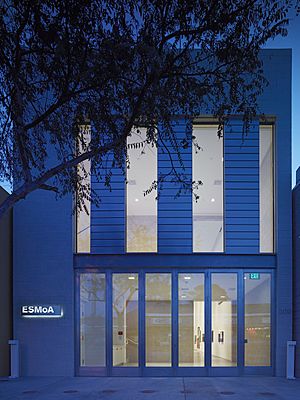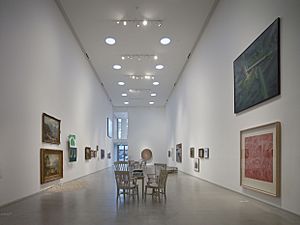ESMoA facts for kids
 |
|
| Lua error in Module:Location_map at line 420: attempt to index field 'wikibase' (a nil value). | |
| Former name | El Segundo Museum of Art |
|---|---|
| Established | 2013 |
| Location | Lawndale, California, |
| Type | Art museum |
ESMoA stands for The Experimentally Structured Museum of Art. It's a special kind of art museum in Lawndale, California. It moved there in 2023 from El Segundo. ESMoA was started in 2013 by Eva Sweeney, Brian Sweeney, and Bernhard Zünkeler. It's run by a non-profit group called Artlab21 Foundation.
ESMoA's main goal is to help people think about creativity in new ways. They do this by showing and teaching about visual arts. Each year, ESMoA offers three "Experiences." These shows feature different types of art, like sculptures, paintings, and photos. The art is grouped by themes or ideas, not by when it was made. ESMoA describes its approach as "Transdisciplinary," "International," "Dynamic," and "Open."
ESMoA also offers art education for everyone. This includes students, families, and adults. The best part is that admission is free! They have school programs, drawing classes, art talks, and family fun days. They even host cooking classes, yoga, dance, and movie nights.
Contents
What is ESMoA?
How ESMoA Started
ESMoA is operated by the Artlab21 Foundation. This is a non-profit group. Before ESMoA opened, two art shows were held in 2011. These shows were at the old El Segundo Fire Station. After that, plans began for a permanent art space. This new space would be called ESMoA. In January 2013, ESMoA officially opened. It was designed to be a working art space focused on learning.
A Top Art Museum
ESMoA was built on an empty lot in downtown El Segundo. In October 2014, a news group called Artnet News listed ESMoA. They named it one of America's Top 10 Private Contemporary Art Museums. This shows how quickly ESMoA became important in the art world.
The ESMoA Building
Modern Design and Space
The ESMoA building is very modern. It is 25 feet wide and 140 feet long. It uses cool materials like stainless steel and white concrete blocks. Eva Sweeney designed the building with John Milander Architects. Specialized Construction built it.
Flexible Galleries
The main gallery inside ESMoA is very tall. It can hold sculptures and paintings that are over two stories high! The museum gets its light from special skylights. These skylights let in natural light. This makes the gallery bright and airy. The light changes with the weather outside. The inside space can also be divided into smaller galleries. This means the museum can create a different look for each "Experience."
ESMoA's Unique Art Experiences
What are "Experiences"?
ESMoA calls its exhibitions "Experiences." This name was chosen to help visitors truly experience the art. It's different from just reading a label in a regular museum. ESMoA uses new ways to show art. Unlike most museums, they display art by theme. They mix art from different time periods and made from all kinds of materials.
Past Themes and Topics
ESMoA has explored many interesting themes. Some early themes included:
- DESIRE: About the environment.
- FAME: About being famous.
- STING: About political conflict, like in Cuba.
- SILENCE: About abstract art.
- SCRATCH: About street art.
- HOME: About architecture and art in homes.
- SPARK: About how artists create.
- STUDIO: About an artist's workspace.
- TOUCH: About the art scene in Los Angeles.
Art Beyond the Museum Walls
Community Art Projects
ESMoA also creates "Experiences" outside its building. They bring art directly to the community. In their first three years, they organized several cool projects:
- An art display on El Segundo Beach called ANTI-ARK.
- A one-day event with body painting called OBJECTIFIED.
- A fun competition for Elvis Presley impersonators called ELVIS WHO?.
- A video projected onto the tower of El Segundo High School called PRIDE CONSTELLATION.
- Two murals that are still standing today. These are on the old El Segundo Post Office and Fire Station. They are called PHYTOMAGNETIC and FIREWATER.
Working with Other Museums
Collaborations and Partnerships
ESMoA loves to work with other museums in Los Angeles. They team up to create exciting art shows.
- The Getty Research Institute helped with the SCRATCH Experience. They showed rare books alongside graffiti art. This explored how artists have worked together over many centuries.
- ESMoA worked with The Wende Museum for the FAME Experience. They looked at the complex spirit of Los Angeles.
- The SPARK Experience explored how famous writer Cornelia Funke worked with Mirada Studios.
- The Los Angeles County Museum of Art (LACMA) helped with the STUDIO Experience. They showed the art of Norbert Tadeusz in the United States for the first time.
- Edward Goldman, an art critic, curated the TOUCH Experience. This show highlighted the Los Angeles art scene from the last 40 years. It included photos of artists in their studios by Jim McHugh. It also featured original artworks by famous artists like Carlos Almaraz, John Baldassari, David Hockney, Ed Moses, Noah Purifoy, Ed Rusha, Alison Saar, and Patssi Valdez.
ESMoA is always talking with these and other museums about new projects. They have also been chosen to join the upcoming Pacific Standard Time: LA/LA project. This big art event is organized by the Getty Foundation.
Learning About Art at ESMoA
How to Explore the Art
ESMoA does not put labels next to the art. But visitors can still learn a lot! They use four different ways to share information:
- ESMoA Virtual Gallery Grid: Each artwork has a number on the floor. Visitors can use iPads in the gallery. The iPads show a simple numbered grid. This grid has basic info about the art, like its title, artist, date, and size. It also has a link to learn more about the artist. Plus, each number has a question to make visitors think. You can even leave a comment! This grid is also on ESMoA's website.
- ESMoA Education Specialists: During opening hours, friendly Education Specialists are there. They can answer any questions you have about the art.
- ESMoA Experience Library: There are tables and chairs in the gallery. Visitors can sit and look at books about the artists or art styles on display.
- Scavenger Hunt: For each "Experience," ESMoA's Education Specialists create fun scavenger hunts. These hunts are related to the art show.
ESMoA Programs for Everyone
School Programs
ESMoA educators create special programs for different age groups. School students are invited to sketch the artworks. They can also create their own art inspired by the show. They use materials like clay, paper, or watercolor pencils.
Adult Programs
ESMoA teams up with restaurants for adult events. Evening programs might include talks, cooking classes, workshops, performances, and movie screenings.
Family Programs
"Family Fun" days happen on some Sundays at ESMoA. These are free programs led by art educators. They are designed for creativity and enjoyment for the whole family. Activities can include tours, family art projects, sketching, and scavenger hunts.
Artists Living and Creating at ESMoA
Artist-in-Residence Program
ESMoA has a special place for artists. On the second floor, there's a studio where artists can live and work. This "Artist-in-Residence" (AIR) space has living areas and a studio. Artists can create new works there. While living at ESMoA, artists can also work with staff and visitors on art projects.
ESMoA works with two art schools to choose artists for this program. They cooperate with Otis College of Art and Design for the spring period. For the summer, they work with London's Royal Drawing School. In its first two years, the program hosted artists from many countries. These included Germany, Iceland, Taiwan, Cuba, Lithuania, the United Kingdom, France, and South Korea.
Art is a State of Mind Documentary
There is a six-part documentary series called Art is a State of Mind. It was made by German filmmaker Aljoscha Pause. The series follows Bernhard Zünkeler for nine years. He is a co-founder of ESMoA, an artist, and a curator. The documentary shows Zünkeler's journey. It covers how he helped create ESMoA and various artist groups.


